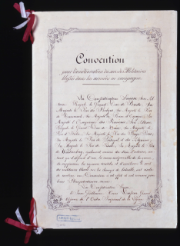The first Geneva Convention “for the Amelioration of the Condition of the Wounded in Armies in the Field”, was signed 150 years ago, on 22 August 1864. The original document from 1864 as well as the Conventions signed in 1949 and still in force today, together with further documentation on the subject, have been digitised by the Federal Archives and can now be viewed on Wikimedia Commons.

In his book "Un souvenir de Solférino" ("A Memory of Solferino"), which was published in 1862, Geneva businessman Henry Dunant documented his observations as an eyewitness to the bloody battle that took place on 24 June 1859. In addition to describing his experiences, he also put forward two proposals for improving the protection afforded to the war-wounded. First, medical personnel should be recognised as neutral parties on the battlefield, enabling them to care for the wounded without hindrance; and second, aid societies for the care of those injured in war should be established in each country. Dunant's ideas were well received throughout Europe, and in 1863 ultimately led to the foundation of the International Committee of the Red Cross (ICRC).
The first Geneva Convention and further developments
Subsequently, the ICRC organised numerous conferences and pushed ahead with the development of international humanitarian law. A diplomatic conference in Geneva in August 1864, convened by the Swiss Federal Council at the request of the ICRC, ultimately led to the signing of the first Geneva Convention "for the Amelioration of the Condition of the Wounded in Armies in the Field". The ICRC worked constantly to adapt the Convention's application in the face of new challenges. In 1899, the Geneva Convention was extended to maritime warfare, while 1929 saw the adoption of the second Geneva Convention on the treatment of prisoners of war.
In 1948 the Federal Council convened a further diplomatic conference in Geneva, to discuss the Conventions and amend them in the light of experience from the Second World War. This resulted in the revision of the existing Conventions, the addition of a new Convention covering the civilian population and the victims of internal armed conflicts, and to the Convention laying down rules for armed conflict at sea. The four Conventions that emerged from this work in 1949 came into force a year later and remain so to this day.
The four Conventions were reaffirmed in 1977 and two Additional Protocols were added, incorporating further rules for the humane conduct of war. A further Additional Protocol added in 2005 provided for the adoption of a fourth distinctive emblem, the Red Crystal, in addition to the Red Cross, the Red Crescent and the Red Lion with Sun (the last of which is used exclusively by Iran). The Geneva Conventions have been signed by 196 states (as of June 2014).
Conservation in the Swiss Federal Archives
Switzerland is the depositary state of the Geneva Conventions, with responsibilities including conserving the original documents. The Federal Archives have digitised the 1864 original, the Conventions concluded in 1949 that are still in force today, as well as further documentation on the subject, and published these on Wikimedia Commons.
Documents in the SFA on the subject
- Übereinkunft vom 22. August 1864 zur Verbesserung des Looses der im Kriege verwundeten Militärs (K1#1777)
- Internationale Übereinkunft vom 6. Juli 1906 zur Verbesserung des Loses der Verwundeten und Kranken der Heere im Felde (K1#1778)
- Abkommen vom 27. Juli 1929 zur Verbesserung des Loses der Verwundeten und Kranken der Heere im Felde (K1#1779)
- Abkommen vom 27. Juli 1929 über die Behandlung der Kriegsgefangenen (K1#3122)
- Genfer Abkommen vom 12. August 1949 (K1#1822)
- Zusatzprotokolle vom 8. Juni 1977 (K1#1000/1414#4165* und K1#1000/1414#4166*)
- Zusatzprotokoll vom 8. Dezember 2005 zu den Genfer Abkommen vom 12. August 1949 über die Annahme eines zusätzlichen Schutzzeichens (K1#5918)
- The Battle of Solferino of 24 June 1859 and Henry Dunant (in German, French and Italian)
Further documents on the subject
- Texts of the Geneva Conventions and the Additional Protocols on the website of the Federal Department of Foreign Affairs
- Information of the Federal Department of Foreign Affairs: The Geneva Conventions in the Federal Archives
- Wikipedia article on the Geneva Conventions
- ICRC information on war and international humanitarian law
Sources
- Historical Lexicon of Switzerland, Rotes Kreuz
http://www.hls-dhs-dss.ch/textes/d/D25812.php (in German, French and Italian) - Federal Department of Foreign Affairs
https://www.eda.admin.ch/eda/en/home/aussenpolitik/voelkerrecht/humanitaeres_voelkerrecht/genfer_konvention.html - Treaties and States Parties to such Treaties http://www.icrc.org/applic/ihl/ihl.nsf/vwTreaties1949.xsp
Further information
Contact
Swiss Federal Archives
Archivstrasse 24
3003 Bern
- Tel.
- +41 58 462 89 89
Opening hours reading room
Tu-Th, 9 a.m. to 7 p.m.





